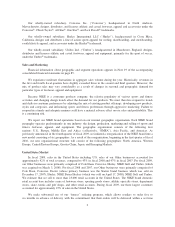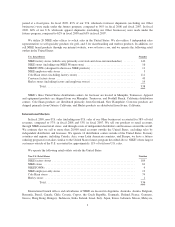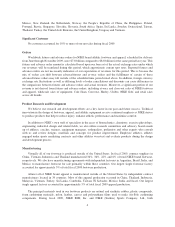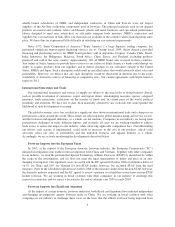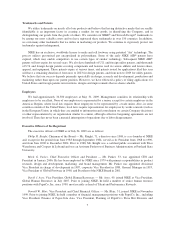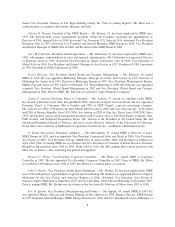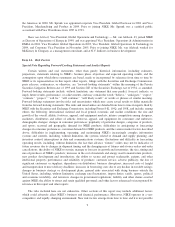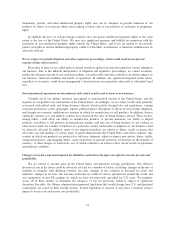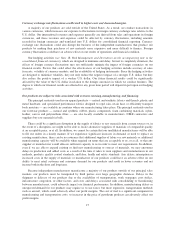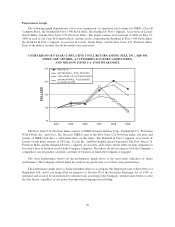Nike 2009 Annual Report Download - page 12
Download and view the complete annual report
Please find page 12 of the 2009 Nike annual report below. You can navigate through the pages in the report by either clicking on the pages listed below, or by using the keyword search tool below to find specific information within the annual report.for management to predict all such risk factors, nor can it assess the impact of all such risk factors on NIKE’s
business or the extent to which any factor, or combination of factors, may cause actual results to differ materially
from those contained in any forward-looking statements. Given these risks and uncertainties, investors should not
place undue reliance on forward-looking statements as a prediction of actual results.
Investors should also be aware that while NIKE does, from time to time, communicate with securities
analysts, it is against NIKE’s policy to disclose to them any material non-public information or other confidential
commercial information. Accordingly, shareholders should not assume that NIKE agrees with any statement or
report issued by any analyst irrespective of the content of the statement or report. Furthermore, NIKE has a
policy against issuing or confirming financial forecasts or projections issued by others. Thus, to the extent that
reports issued by securities analysts contain any projections, forecasts or opinions, such reports are not the
responsibility of NIKE.
Our products face intense competition.
NIKE is a consumer products company and the relative popularity of various sports and fitness activities
and changing design trends affect the demand for our products. The athletic footwear, apparel and equipment
industry is keenly competitive in the United States and on a worldwide basis. We compete internationally with a
significant number of athletic and leisure shoe companies, athletic and leisure apparel companies, sports
equipment companies, and large companies having diversified lines of athletic and leisure shoes, apparel and
equipment. We also compete with other companies for the production capacity of independent manufacturers that
produce our products and for import quota capacity.
Our competitors’ product offerings, technologies, marketing expenditures (including expenditures for
advertising and endorsements), pricing, costs of production, and customer service are areas of intense
competition. This, in addition to rapid changes in technology and consumer preferences in the markets for
athletic and leisure footwear and apparel, and athletic equipment, constitute significant risk factors in our
operations. If we do not adequately and timely anticipate and respond to our competitors, our costs may increase
or the consumer demand for our products may decline significantly.
If we are unable to anticipate consumer preferences and develop new products, we may not be able to
maintain or increase our net revenues and profits.
Our success depends on our ability to identify, originate and define product trends as well as to anticipate,
gauge and react to changing consumer demands in a timely manner. All of our products are subject to changing
consumer preferences that cannot be predicted with certainty. Our new products may not receive consumer
acceptance as consumer preferences could shift rapidly to different types of performance or other sports apparel
or away from these types of products altogether, and our future success depends in part on our ability to
anticipate and respond to these changes. If we fail to anticipate accurately and respond to trends and shifts in
consumer preferences by adjusting the mix of existing product offerings, developing new products, designs,
styles and categories, and influencing sports and fitness preferences through aggressive marketing, we could
experience lower sales, excess inventories and lower profit margins, any of which could have an adverse effect
on our results of operations and financial condition.
We rely on technical innovation and high quality products to compete in the market for our products.
Although design and aesthetics of our products appear to be the most important factor for consumer
acceptance of our products, technical innovation and quality control in the design of footwear, apparel, and
athletic equipment is also essential to the commercial success of our products. Research and development plays a
key role in technical innovation. We rely upon specialists in the fields of biomechanics, exercise physiology,
engineering, industrial design and related fields, as well as research committees and advisory boards made up of
athletes, coaches, trainers, equipment managers, orthopedists, podiatrists and other experts to develop and test
10




